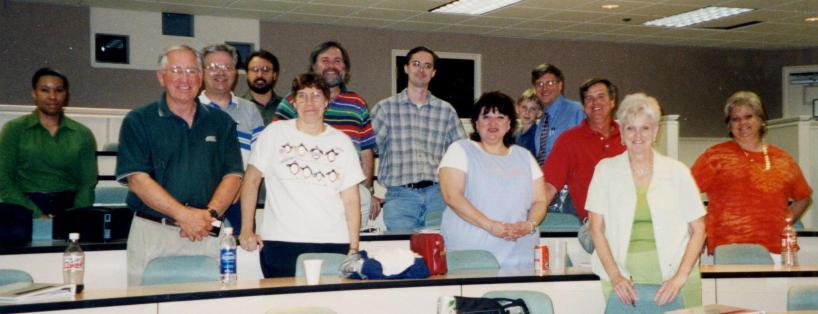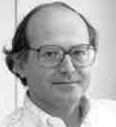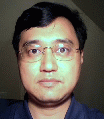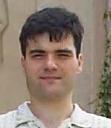
SMU QuarkNet High School Science Teachers Workshop

Jewels of Modern Physics (PowerPoint 31M)
Quantum Mechanics (PowerPoint 15M)
Pre-AP Quantum Mechanics (PowerPoint 19M)
Atomic Spectra Lab (PowerPoint 6.8M)
The 2002-2003 Collegium da Vinci series also includes a free public lecture on Sept. 29, 2002. This lecture will feature James Randi, author of the 1995 book, An Encyclopedia of Claims, Frauds, and Hoaxes of the Occult and Supernatural. Randi will present an entertaining overview demonstrating how science has pursued magic and miracles in the 20th century and into the 21st century in a lecture titled “The Search for the Chimera.”
Search for the Chimera
An Overview of How Science Has Pursued Magic and Miracles in the 20th Century and Into the 21st CenturyJames Randi exposes popularly-accepted fakery by discussing with his audience everything from UFOs to the Bermuda Triangle, from the Von Däniken "Chariots of the Gods" fraud to the notion of a lost continent named Atlantis. Randi reveals what really took place in the last three decades in the labs of various prestigious "think tanks" that verified a series of simple magicians tricks as genuine miracles, thus launching a world-wide plague of misinformation, the repercussions of which can still be felt today.
This unique and provocative lecture is not only educational but also highly entertaining. It attracts persons of all educational and social backgrounds and provides a rational perspective on the seemingly paranormal and otherwise unexplained happenings in our day-to-day life.
Mr. Randi illustrates how a "politically-correct" attitude has blinded scientists — who should know better — to the fact that they are not proficient at detecting fraud, often managing to fool themselves, when the prize is sufficiently attractive. And he puts up a million-dollar award as bait!
Ph.D., Stanford, 1978.
Bruce V. & Diana M. Rauner Distinguished Service Professor, Depts.
of Astronomy & Astrophysics and Physics, Enrico Fermi Institute, and
the College, and Chairman, Department of Astronomy & Astrophysics.
Theoretical astrophysics, cosmology and elementary particle physics,
cosmology.
Current specific areas of research include: big-bang nucleosynthesis in era of precision cosmology; theoretical aspects of inflationary cosmology; testing the inflationary paradigm; determining the nature of the dark energy that is causing the Universe to accelerate; dark matter and dark-matter detection; dark matter and the formation of structure in the Universe; the origin of the cosmic asymmetry between matter and antimatter; understanding how to use precision measurements of the fine-scale anisotropy of the cosmic microwave background and large-scale structure to probe inflation and fundamental physics; and aspects of axion, neutrino and string cosmology.
Fred Olness' presentation:
PDF Format (1.8 MB) or
PPT Source (gzip format 2.0 MB)
Darren Carollo' presentation: PDF Format (xxx MB) or PPT Source (gzip format XXX MB) (under constrution)
Ken Taylor's Lectures on Accelerating Particles: PDF Format (4.9 MB) or PPT Source (zip format 4.5 MB)
Andrew White's Lectures on Fermilab Run II (under constrution)
Will Burgett's Lectures on Cosmic Rays (under constrution)
Larry Grise's Information about Rutherford Scattering Lab (text file)
Ryszard Stroynowski's Lectures on the Goals of Particle Physics: PDF Format (434KB) or PPT Source (764KB)
Tamara Trout's Lectures on General Relativity: : PDF Format (2.6 MB) or PPT Source (gzip format 89 KB)
Chaos Circuit: How To Build Using OpAmps: : PDF Format (402KB) or ps.gz (487KB)
Sandra Lyman's report on Particle Detectors in Physics: Word.doc format (71 KB)
Richard Lines' report on the Cosmic Ray Telescope: PDF Format (277 KB) or PPT Source (251KB)
Randy Scalise's note on the cantilevered blocks demonstration:
Text
file (3K)

|
![[Fredrick I. Olness]](fred.gif)
|

|
| Professor Ryszard Stroynowski | Professor Fred Olness | Professor Tom Coan |

|
 |

|
| Professor Randall J. Scalise | Dr. Jingbo Ye | Dr. Pavel Nadolsky |
| Darren Carollo | Lincoln High School |
| Larry Grise | Metropolitan Christian School |
| Ken Taylor | Lake Highlands High School |
| Tamara Trout | SMU |
Fermilab Web-based Instructional Materials
Online educational
resources for Physics teachers
A collection of Java applets from Italy
NTNU Virtual Physics
Laboratory (Java Applets)
(seems not to work in Netscape, only Internet Explorer)
Contemporary Physics Education Project
Particle Physics Education and Information sites
CERN Microcosom: Discover
the World of Particles
National Academy of Sciences Press webpage
Inquiry and the National Science Education Standards, National Research Council,National Academy of Sciences: Board On Physics And Astronomy Reports:
Connecting Quarks with the Cosmos: Eleven Science Questions for the New Century
The Geometry Center is a mathematics research and education center at the University of Minnesota. The Center has a unified mathematics computing environment supporting math and computer science research, mathematical visualization, software development, application development, video animation production, and K-16 math education.
http://www.physicsweb.org/
features great articles on current physics research
and discoveries including some great links to other sites
http://www.physicsweb.org/TIPTOP/http://www.ba.infn.it/www/didattica.html
Welcome to tiptop - the best place to explore physics on the web. tiptop is a vast collection of online resources provided by the physics community for the physics community. Enjoy your visit.http://www.physicsweb.org/TIPTOP/VLAB/
Not only includes links to great java applet simulations of neat phenomenon, but also links to University virtual labs with multiple simulations. The only problem is LOTS of sites with no particular organization.
http://www.ba.infn.it/%7ezito/museo/leonardoen.htmlhttp://www.scri.fsu.edu/~jac/Nuclear/
Over 200 links to math, and physics (and a few to other sicence areas as well) animations and java applet simulations.
http://www.nsrl.ttu.edu/chernobyl/ang.htm
Interesting site describing the Chernobyl accident
and research on the environment in the aftermath.
http://integratingtheinternet.com/index/sci.html
Bill Nye the Science Guy, need I say more?
Sandra Lyman's report on Particle Detectors in Physics: Word.doc
format
http://btc002.msu.montana.edu/nten/home.shtml
Main site for NTEN (National Teacher's Enhancement
Network):
http://btc002.msu.montana.edu/ceres/http://www.geocities.com/janeway2001/
Site for the CERES (We downloaded SCION imaging software and worked extensively with it...all freely obtainable by students and teachers)
http://www.geocities.com/janeway2001/dailyhw.htmlhttp://www.louisiana.edu/Academic/Bulletin/UN/id638.htm
For my final project in the Planetary Cosmology course I put together a Planetary Measurement Unit Based on Imaging software and other activities. Please feel free to provide this link to teachers. I put many hours in on this planning.